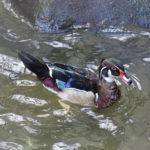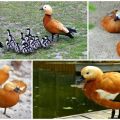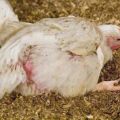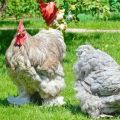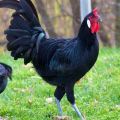The appearance and characteristics of the Caroline ducks, where the breed lives and its diet
Caroline ducks are birds of the duck family. Bright feathers are considered their distinctive feature. These birds are the closest relatives of the Asian mandarin. In natural conditions, birds live in North America. At the same time, birds are often bred in European parks, from which they often end up in the wild. The basis of the diet of individuals is plant and animal feed.
Where do they live?
These birds originally lived in North America. Subsequently, they became widespread in Europe. The birds were kept there in city parks. From there, they gradually began to fall into the wild and gradually assimilated there. Today these birds are found in different countries - France, England, Germany. At home, they live near water bodies - small lakes, slow rivers or swamps. Karolinki willingly settle near low lakes, which flood the trees.
Lifestyle
Caroline ducks don't only live in water. They also mastered the land. Representatives of this breed prefer closed areas. Birds often choose places with hanging tree branches. They hide birds from predatory animals and provide a safe hiding place.
In winter, ducks form large flocks, which include up to 1000 individuals. They often fly from freshwater bodies of water to mixed waters. This helps in finding food. At the same time, it is impossible to meet caroline in open areas or on the sea coast. Birds prefer to avoid such areas. The birds' lifestyle is closely related to the forest. Therefore, they learned to fly beautifully, masterfully bending around trees. Also birds can swim perfectly. When in danger, they can dive.
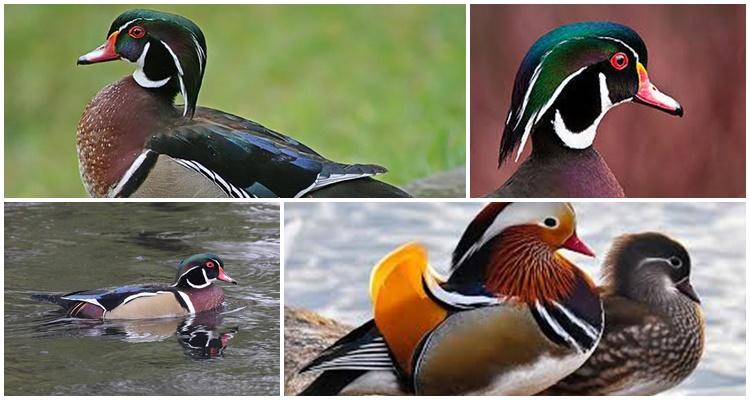
Appearance and characteristics
Karolinka is considered one of the most beautiful and colorful birds in the world. Its body length is approximately 50 centimeters, and its wingspan is 70. The birds weigh from 480 to 780 grams. At the same time, males are superior to females in size.
A distinctive feature of birds is their color. They are characterized by a black head, which has a greenish or purple tint. It is decorated with long white stripes. The red beak with a white spot contrasts with the shade of the head. The beak has a yellow base and a black tip. The bird also has red eyelids and eyes.
Feathers include several areas:
- brown breast covered with white dots;
- lemon flanks and light brown body;
- white belly.
In this case, the color of the outer part of the wings and back coincides with the head. Additional shades are characteristic of the secondary parts of the body. The rib cage is separated from the remaining body by 2 stripes - white and black. We should also mention the long crest. It descends from the head to the back of the neck.
The specified description is more consistent with the male. Moreover, the female is characterized by a less spectacular color. Young birds, regardless of gender, are similar to an adult female. If the male becomes more variegated, this indicates the onset of puberty.
In appearance, the Carolina is similar to the mandarin duck that lives in Asia, these birds are considered close relatives.
Diet
Birds are characterized by daytime activity. They eat the following food categories:
- Vegetable - water lilies, duckweed, nuts, seeds. Ducks also eat mulberries or grapes. They can eat small acorns. When there is a shortage of food, the birds eat the crops of the fields. These include millet, soybeans, corn, and oats.
- Animals - ducks eat spiders, fish fry and various insects. Carolina can eat dragonflies, ants, grasshoppers.
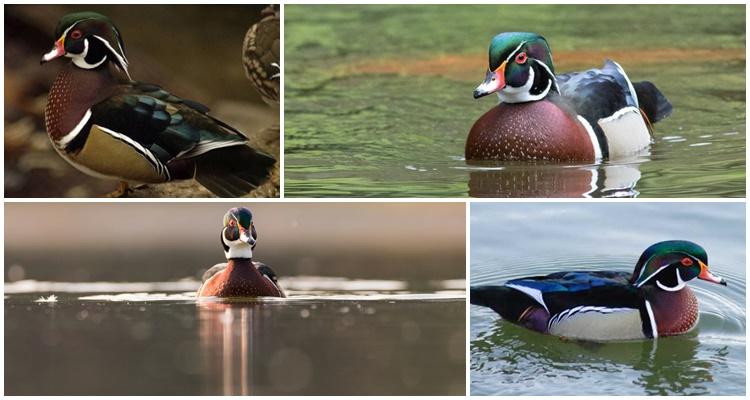
Breeding features
Already at 2 years of age, birds are able to reproduce. They are considered monogamous, but couples are predominantly created for one season. In the spring - in March and April - ducks are actively looking for secluded places in which to build a nest. Before the start of the breeding season, ducks have long mating games.
During these periods, individuals assume characteristic positions on the water. In this case, the male pretends that he drinks and peels feathers, turns the back of the head towards the female, lifts the crest.
The initiator of mating games is the female, and not the male, as is customary with other birds. For a nest, ducks use hollows or artificially made nest boxes. They are placed 9 meters from the earth's surface and not far from water bodies. Sometimes carolines use the holes that other birds leave. The female is responsible for choosing a nest in birds.
The bird sprinkles the eggs with wood dust and plant debris. She uses her down as an additional insulating layer. In addition to protection from the influence of cold weather, such a shelter protects the masonry from predatory animals. Carolinkas lay 12-15 eggs and incubate them for a month. The male stays near the female for 3 weeks. After that, he flies away. During this period, drakes molt. On the remaining days, the duck briefly flies out of the nest in the morning or evening in search of food.
A day after birth, the chicks get out on a branch to jump to the ground. Mom is waiting for them below. When the ducklings hit the ground, they go to the water. At this time, mother teaches them to find food and in the first weeks provides reliable protection from enemies. After a while, mom flies off to molt. Birds take wing at 2 months.
The subtleties of keeping in captivity
Caroline ducks have been bred in captivity for a long time. In optimally selected conditions, birds can live up to 30 years. To do this, they need an aviary of at least 3 square meters for 1-2 birds. Stainless steel is used as a material for the frame. At the same time, it is worth placing ordinary sand about 20 centimeters thick on the floor. A prerequisite for birds is the presence of a reservoir. It should be at least 70 centimeters in diameter.
In order for birds to nest and breed, a box must be placed in the aviary. It serves as a replacement for the usual duck nest. In appearance, the structure looks like a birdhouse. It is placed at a height of 1.5 meters from the floor.
Birds can hardly withstand hot weather.At high temperatures, their plumage falls out and becomes dull. In winter, pets live in a dry and warm room - a barn is perfect for this.
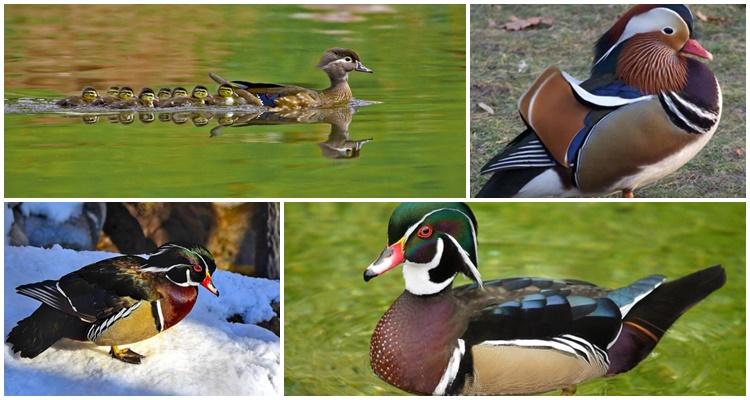
What to feed and how to breed at home
Carolins mainly feed on plant foods. They can also eat insects. The diet is based on the following foods:
- seeds;
- cereals;
- aquatic crops;
- legumes;
- corn;
- invertebrate insects;
- oats;
- plant buds.
Breeding Caroline ducks is not difficult. It is important that the female has a cozy nest. At this time, she needs a sufficient amount of protein and calcium. The poultry clutch contains a maximum of 12 eggs. In this case, ducklings are removed from almost all.
pros
The advantages of caroline include the following:
- spectacular appearance;
- strong immunity;
- large masonry;
- high parameters of chick survival;
- the ability to adapt to different climates.
Caroline ducks are distinguished by their bright plumage, and therefore look very impressive. Mostly birds live in the wild, but they can also be bred in captivity.


